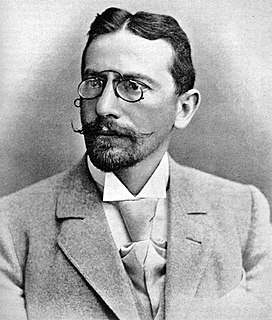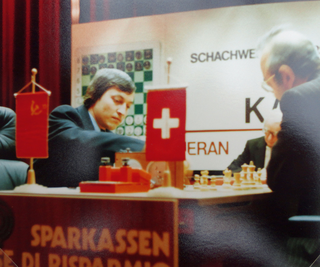Examples
1.
| This section uses algebraic notation to describe chess moves. |
| a | b | c | d | e | f | g | h | ||
| 8 |  | 8 | |||||||
| 7 | 7 | ||||||||
| 6 | 6 | ||||||||
| 5 | 5 | ||||||||
| 4 | 4 | ||||||||
| 3 | 3 | ||||||||
| 2 | 2 | ||||||||
| 1 | 1 | ||||||||
| a | b | c | d | e | f | g | h | ||
The problem to the right is a relatively simple example by William Shinkman, published in White Rooks, 1910. It is a mate in three (white moves first and must checkmate black in three moves against any defence). The key (first move of the solution) is 1.d5. Examining the initial position reveals why this works: white would like to play either 1.Ra8 or 1.Rg8, but the former is prevented by black's bishop and the latter is prevented by black's queen. 1.d5 blocks the paths of both black pieces to these squares, and whichever black piece takes the pawn interferes with the other and has to defend against both threats itself (to use chess jargon, it becomes overloaded). So, if 1...Qxd5 white can play 2.Ra8+ Qxa8, when the queen is deflected from her defence of g8, allowing 3.Rg8#, while if 1...Bxd5 white can play 2.Rg8+ Bxg8, deflecting the bishop from defence of a8, allowing 3.Ra8#.
2.
| a | b | c | d | e | f | g | h | ||
| 8 |  | 8 | |||||||
| 7 | 7 | ||||||||
| 6 | 6 | ||||||||
| 5 | 5 | ||||||||
| 4 | 4 | ||||||||
| 3 | 3 | ||||||||
| 2 | 2 | ||||||||
| 1 | 1 | ||||||||
| a | b | c | d | e | f | g | h | ||
To the right is another relatively simple example, but this time it is two rooks, rather than bishop and queen, involved in the interferences. The problem, by D. J. Densmore, published in the Gazette-Times, 1916, is another mate in three. The key is 1.Nb7, which interferes with both rooks and so threatens both 2.Rh7# and 2.Rb1#. Black can defend with Raxb7, but this overloads the capturing rook, so white can play 2.Rb1+ Rxb1 3.Rh7#. The other capture is similar: 1...Rbxb7 2.Rh7+ Rxh7 3.Rb1#. Whichever rook captures, it interferes with the other and becomes overloaded, having to defend against two threats on its own.
3.
Sahovski Glasnik, 1991
| a | b | c | d | e | f | g | h | ||
| 8 |  | 8 | |||||||
| 7 | 7 | ||||||||
| 6 | 6 | ||||||||
| 5 | 5 | ||||||||
| 4 | 4 | ||||||||
| 3 | 3 | ||||||||
| 2 | 2 | ||||||||
| 1 | 1 | ||||||||
| a | b | c | d | e | f | g | h | ||
A more sophisticated modern example is the award-winning mate-in-four problem to the right by Aleksandr N. Pankrat'ev and Josip Varga, which was published in Sahovski Glasnik in 1991 and won 1st prize. White begins with 1.e3, adding protection to d4 and threatening 2.Rc5#. Black's two main defenses are the two captures on e3, but each one allows a different Plachutta interference by White on move 2. If 1...Rxe3, White plays 2.f4!, a Plachutta interference with the queen and bishop: 2...Qxf4 allows 3.Nxe3+ Qxe3 4.Nxe5# and 2...Bxf4 allows 3.Nxe5+ Bxe5 4.Nxe3#. If 1...Bxe3, White plays 2.Bb3+!, a Plachutta interference with the two black rooks: 2...Rbxb3 allows 3.Nxe3+ Rxe3 4.Nb6# and 2...Raxb3 allows 3.Nb6+ Rxb6 4.Nxe3#.
- 1.e3 anything-else 2. Rc5#
- 1.e3 Rxe3 2.f4 Qxf4 allows 3.Nxe3+ Qxe3 4.Nxe5#.
- 1.e3 Rxe3 2.f4 Bxf4 allows 3.Nxe5+ Bxe5 4.Nxe3#.
- 1.e3 Bxe3 2.Bb3+ Rbxb3 allows 3.Nxe3+ Rxe3 4.Nb6#.
- 1.e3 Bxe3 2.Bb3+ Raxb3 allows 3.Nb6+ Rxb6 4.Nxe3#
4.
| a | b | c | d | e | f | g | h | ||
| 8 |  | 8 | |||||||
| 7 | 7 | ||||||||
| 6 | 6 | ||||||||
| 5 | 5 | ||||||||
| 4 | 4 | ||||||||
| 3 | 3 | ||||||||
| 2 | 2 | ||||||||
| 1 | 1 | ||||||||
| a | b | c | d | e | f | g | h | ||
Although the term Plachutta is confined to the world of chess problems, not being used in a wider chess context, the underlying Plachutta pattern does occasionally (though rarely) appear in an actual game. One example is to the right, a position which occurred in a 1914 game between Siegbert Tarrasch (with white) and a team of opponents consisting of Davide Marotti (who became the champion of Italy in 1921), E. Napoli, de Simone, and del Giudice. [1] In the diagrammed position, the black queen defends against Qb7 and the rook on c8 defends against Rxc5. Tarrasch played 31.Bc7!, a Plachutta interference after which black cannot maintain control over both b7 and c5 (black actually resigned after this move). If 31...Rxc7 the rook is overloaded, having to look after both the key squares: 32.Qb7+ Rxb7 and the rook is deflected from defence of c5, allowing 33.Rxc5#. If instead 31...Qxc7 it is the queen which is overloaded: 32.Rxc5+ Qxc5 deflects the queen from defence of b7, allowing 33.Qb7+ Kxa5 34.Ra1#. [2] [3]














